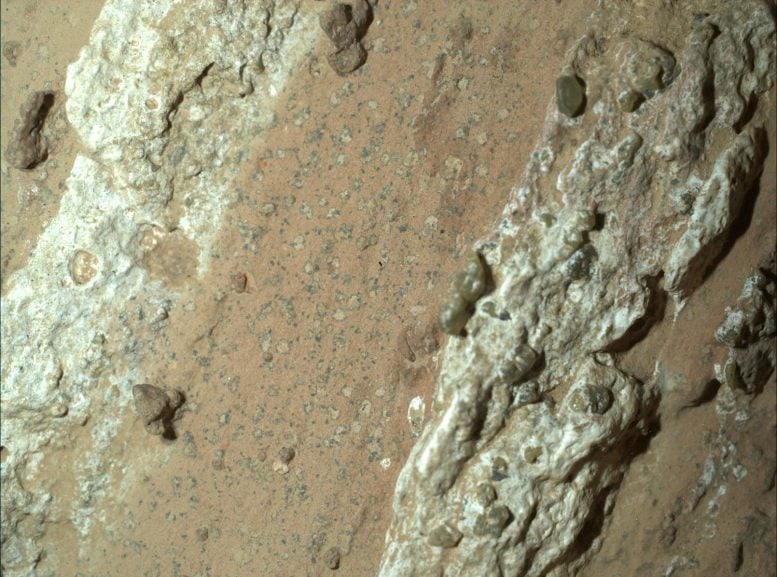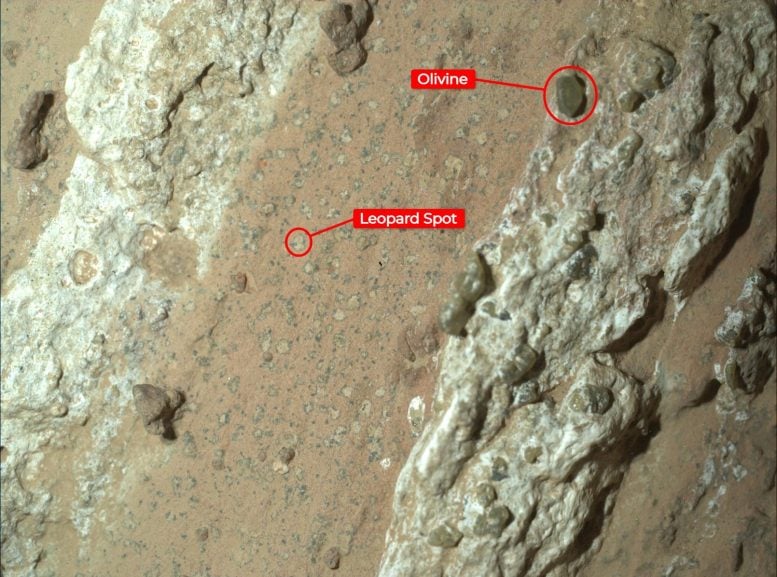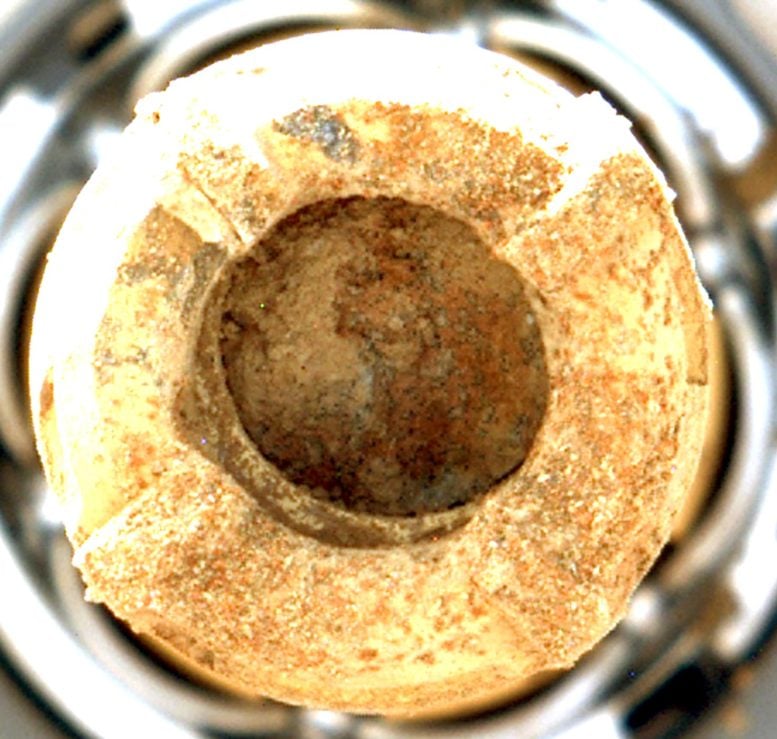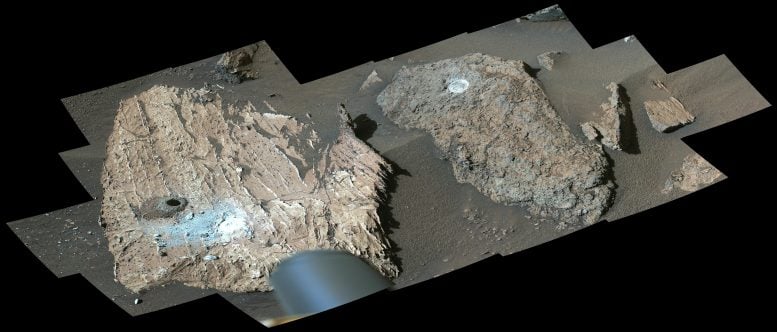
NASA’s Perseverance rover has discovered an intriguing rock on Mars, named Cheyava Falls, showcasing potential signs of ancient life due to its unique chemical signatures and structural features.
This finding, supported by the presence of organic compounds and distinct color patterns suggestive of microbial activity, fuels ongoing research to determine Mars’s habitability.
Discovery of Cheyava Falls Rock
A vein-filled rock is catching the eye of the science team of NASA’s Perseverance rover. Nicknamed “Cheyava Falls” by the team, the arrowhead-shaped rock contains fascinating traits that may bear on the question of whether Mars was home to microscopic life in the distant past.

Analysis by instruments aboard the rover indicates the rock possesses qualities that fit the definition of a possible indicator of ancient life. The rock exhibits chemical signatures and structures that could possibly have been formed by life billions of years ago when the area being explored by the rover contained running water. Other explanations for the observed features are being considered by the science team, and future research steps will be required to determine whether ancient life is a valid explanation.

Sample Collection and Exploration Strategy
The rock — the rover’s 22nd rock core sample — was collected on July 21, as the rover explored the northern edge of Neretva Vallis, an ancient river valley measuring a quarter-mile (400 meters) wide that was carved by water rushing into Jezero Crater long ago.
“We have designed the route for Perseverance to ensure that it goes to areas with the potential for interesting scientific samples,” said Nicola Fox, associate administrator, Science Mission Directorate at NASA Headquarters in Washington. “This trip through the Neretva Vallis riverbed paid off as we found something we’ve never seen before, which will give our scientists so much to study.”

Multiple scans of Cheyava Falls by the rover’s SHERLOC (Scanning Habitable Environments with Raman & Luminescence for Organics & Chemicals) instrument indicate it contains organic compounds. While such carbon-based molecules are considered the building blocks of life, they also can be formed by non-biological processes.
“Cheyava Falls is the most puzzling, complex, and potentially important rock yet investigated by Perseverance,” said Ken Farley, Perseverance project scientist of Caltech in Pasadena. “On the one hand, we have our first compelling detection of organic material, distinctive colorful spots indicative of chemical reactions that microbial life could use as an energy source, and clear evidence that water — necessary for life — once passed through the rock. On the other hand, we have been unable to determine exactly how the rock formed and to what extent nearby rocks may have heated Cheyava Falls and contributed to these features.”
Other details about the rock, which measures 3.2 feet by 2 feet (1 meter by 0.6 meters) and was named after a Grand Canyon waterfall, have intrigued the team, as well.

How Rocks Get Their Spots
In its search for signs of ancient microbial life, the Perseverance mission has focused on rocks that may have been created or modified long ago by the presence of water. That’s why the team homed in on Cheyava Falls.
“This is the kind of key observation that SHERLOC was built for — to seek organic matter as it is an essential component of a search for past life,” said SHERLOC’s principal investigator Kevin Hand of NASA’s Jet Propulsion Laboratory in Southern California, which manages the mission.
Running the length of the rock are large white calcium sulfate veins. Between those veins are bands of material whose reddish color suggests the presence of hematite, one of the minerals that gives Mars its distinctive rusty hue.

Unusual Mineral Patterns and Their Implications
When Perseverance took a closer look at these red regions, it found dozens of irregularly shaped, millimeter-size off-white splotches, each ringed with black material, akin to leopard spots. Perseverance’s PIXL (Planetary Instrument for X-ray Lithochemistry) instrument has determined these black halos contain both iron and phosphate.
“These spots are a big surprise,” said David Flannery, an astrobiologist and member of the Perseverance science team from the Queensland University of Technology in Australia. “On Earth, these types of features in rocks are often associated with the fossilized record of microbes living in the subsurface.”

Spotting of this type on sedimentary terrestrial rocks can occur when chemical reactions involving hematite turn the rock from red to white. Those reactions can also release iron and phosphate, possibly causing the black halos to form. Reactions of this type can be an energy source for microbes, explaining the association between such features and microbes in a terrestrial setting.
In one scenario the Perseverance science team is considering, Cheyava Falls was initially deposited as mud with organic compounds mixed in that eventually cemented into rock. Later, a second episode of fluid flow penetrated fissures in the rock, enabling mineral deposits that created the large white calcium sulfate veins seen today and resulting in the spots.
NASA’s Perseverance rover has made very compelling observations in a Martian rock that, with further study, could prove that life was present on Mars in the distant past — but how can we determine that from a rock, and what do we need to do to confirm it? Morgan Cable, a scientist on the Perseverance team, takes a closer look. Credit: NASA/JPL-Caltech
Another Puzzle Piece
While both the organic matter and the leopard spots are of great interest, they aren’t the only aspects of the Cheyava Falls rock confounding the science team. They were surprised to find that these veins are filled with millimeter-sized crystals of olivine, a mineral that forms from magma. The olivine might be related to rocks that were formed farther up the rim of the river valley and that may have been produced by crystallization of magma.
If so, the team has another question to answer: Could the olivine and sulfate have been introduced to the rock at uninhabitably high temperatures, creating an abiotic chemical reaction that resulted in the leopard spots?

“We have zapped that rock with lasers and X-rays and imaged it literally day and night from just about every angle imaginable,” said Farley. “Scientifically, Perseverance has nothing more to give. To fully understand what really happened in that Martian river valley at Jezero Crater billions of years ago, we’d want to bring the Cheyava Falls sample back to Earth, so it can be studied with the powerful instruments available in laboratories.”
Mission Overview
The NASA Perseverance rover, a cornerstone of the Mars 2020 mission, is tasked with a groundbreaking exploration focused primarily on astrobiology. Its primary mission is to search for signs of ancient microbial life, paving the way for future human missions by thoroughly characterizing Mars’s geology and climate. This sophisticated rover is the first of its kind designed not only to study Martian surface features but also to collect and cache samples of rock and regolith. These samples are intended to be retrieved and brought back to Earth under NASA’s Mars Sample Return Program, in collaboration with the European Space Agency (ESA), for comprehensive analysis.
This ambitious mission is an integral part of NASA’s broader Moon to Mars exploration strategy, which also includes the Artemis missions to the Moon. These lunar missions serve as a preparatory step towards the ultimate goal of human exploration of Mars. The Perseverance rover itself is managed by NASA’s Jet Propulsion Laboratory, operated by Caltech, ensuring top-tier oversight and execution of its operations on the Martian surface. This strategic approach aims not only to uncover the mysteries of Martian life and history but also to lay the groundwork for the next giant leap in human space exploration.
[Editor’s Note: The article’s title was revised to more accurately reflect the discovery of potential biosignatures, not biosignatures.]
7 Comments
Whom then are the beneficiaries of global conspiracy? Often in a controlled-opposition environment, you’ll find amateur conspiracy theorists railing against a particular race, religion, or creed. You’ll see conspirator accusations thrown at ‘The British’, ‘The Jews’, non-human ETs, dimensional demons, or even ‘The Devil’ himself. It’s important to understand the Deep State is loyal to no race, religion, or creed, but rather only to their * family*. If you see any corporate shills like David Icke accusing an entire race or alien species of a conspiracy, just remember, they are just being racist.
Q: Where is the Deep State?
Martial Law. Maritime. Marshalling. Marching. Mergers. Martyrdom. Murder. Marring. These familiar terms of conquest are named after the planet of conquest: Mars. The origins of these words suggest systems of control imposed upon us by humans who associate themselves with the planet Mars. The headquarters of the Deep State is located in the secret places of the Earth, as well as places we were told Humans cannot live, like on the inside of the planet Mars.
Q: Why would the Deep State be on Mars?
Ancient testimony tells us the ‘true’ origin story of Earth, Mars, Venus, Saturn, Jupiter, and the Sun! (oh and the other planets were sorta involved too). The real history of our solar system is recent, not millions or billions of years long. Earth shares an incubated safe space with Mercury, Venus, and Mars that allows for periodic quantum entanglement without interference. Occasionally, Birkeland currents will flow between these planets. The coma tail of Venus prevents quantum entanglement and safe travel, as does the asteroid belt. Mercury may be a viable quantum-tunnel travel location. The most natural and safest periodic quantum gates exist between Earth and Mars. These gates were formed during inter-planetary discharges of electricity, the same kind of lightning scarring that carved the Grand Canyon.
Huh?
This is nutz on a new level. The Deepstate on mars? Wtf dude!
Behold the average modern day ‘centrist’ folks. The right wing is apparently even worse than the cuckoo who left the comment.
Bullcrap superstition. No scientific evidence till we slin past mercury to marse in a jiffy of time.
If you say so.
I hope there were or still is life on mars..It will be amazing…Keep Looking don’t ever stop…